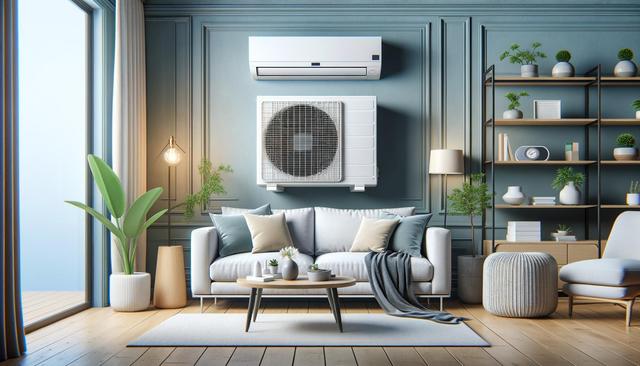Ductless AC Units: Is it wotrthy? How can i get it?
Ductless AC units are becoming increasingly popular, but are they the right choice for your cooling needs?

Understanding Ductless AC Units
Ductless AC units, also known as mini-split systems, are air conditioning systems that don’t require ductwork to cool or heat a space. These systems consist of two main components: an outdoor compressor and an indoor air-handling unit. The two are connected by a conduit which houses the power cable, refrigerant tubing, suction tubing, and a condensate drain. This setup allows for a flexible and efficient cooling solution, especially in homes or buildings where installing or extending ductwork is impractical or too costly.
Unlike traditional central air systems, ductless AC units can be installed in individual rooms or zones. This means you can cool specific areas based on usage, which can contribute to energy savings. They’re also known for their quiet operation and sleek design, making them suitable for modern interiors. Whether you’re upgrading an older home, adding a new room, or simply seeking better temperature control, a ductless AC system could be a practical choice.
Advantages of Going Duct-Free
There are several compelling reasons homeowners and property managers are turning to ductless AC units. While upfront costs can vary, the long-term benefits often justify the investment. Some of the main advantages include:
- Energy Efficiency: Ductless systems typically use less power due to their size and zone-based approach.
- Easy Installation: Since they don’t require ductwork, installation is faster and less invasive.
- Customizable Comfort: Each indoor unit can be controlled independently, allowing for personalized temperature control in different rooms.
- Improved Indoor Air Quality: With multi-layer filtration systems, ductless ACs can reduce dust, allergens, and other particulates in the air.
These features make ductless air conditioning a suitable option for both residential and commercial settings. However, it’s important to assess your specific needs and consult with a qualified HVAC professional before making a decision.
Potential Limitations to Consider
While ductless AC units offer many benefits, they may not be the ideal choice for every situation. Understanding the potential drawbacks can help you make an informed decision. Some limitations include:
- Higher Initial Cost: Compared to window units or portable ACs, ductless systems can be more expensive upfront.
- Maintenance Requirements: Regular maintenance, including filter cleaning and occasional servicing, is essential to keep the system running efficiently.
- Aesthetic Impact: Although the indoor units are compact, some homeowners might not prefer having visible fixtures on their walls.
- Cooling Capacity: For larger homes, multiple units may be needed, which can increase the overall cost.
Despite these considerations, many users find the long-term energy savings and improved comfort outweigh the initial expenses. Evaluating your property size, insulation, and usage habits can help determine if a ductless setup is appropriate.
How to Get a Ductless AC System Installed
If you’ve decided that a ductless AC unit is right for your home or office, the next step is to find a reputable HVAC contractor. Here’s a basic guide on how to get started:
- Research Local Providers: Look for licensed and experienced HVAC companies in your area that specialize in ductless systems.
- Request a Consultation: A technician will typically visit your property to assess your needs, determine the number of units required, and recommend system models.
- Get a Quote: Ask for a detailed estimate that includes equipment costs, installation fees, and any warranties offered.
- Schedule Installation: Once you agree to the terms, the installation process usually takes one to two days depending on the complexity of the job.
It’s a good idea to get multiple quotes to compare pricing and services. Also, ask about any available rebates or energy efficiency incentives that could reduce your overall costs.
Is a Ductless AC Unit Worth It?
Whether a ductless AC unit is worth it largely depends on your specific needs and existing infrastructure. For homeowners without existing ductwork, or for those seeking a more energy-efficient and customizable cooling solution, ductless systems can offer substantial benefits. They are especially effective in spaces like older homes, home additions, and areas that require independent climate control.
On the other hand, if your home already has a functioning ducted system, upgrading to a ductless AC may not provide enough added value to justify the expense. However, they can still be used as supplementary systems in specific rooms where your central system underperforms.
Ultimately, the decision should be based on a combination of comfort preferences, energy savings goals, and budget. Consulting with an HVAC expert can help you explore your options and determine if a ductless AC system is truly the right fit for your property.
Final Thoughts: Making an Informed Cooling Decision
Ductless AC units offer a modern and flexible approach to indoor climate control, especially suited for homes and buildings without existing ductwork. While they come with an upfront investment, their efficiency, zone-based cooling, and overall comfort make them a valuable option for many. Before making a purchase, assess your property’s layout, your cooling needs, and your long-term energy goals. With proper installation and maintenance, a ductless AC system can serve as a reliable solution for years to come.